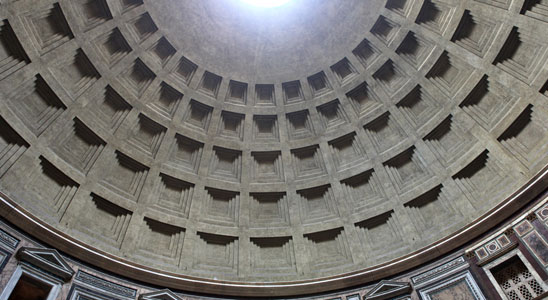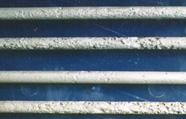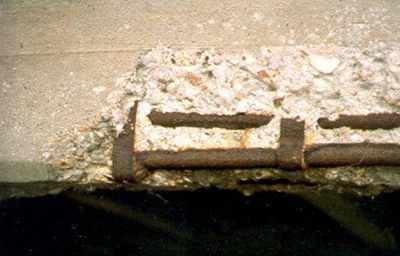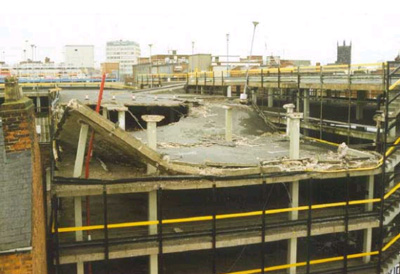KNOWLEDGE LIBRARY
CORROSION OF STEEL IN CONCRETE
Document Type: Guidance Note
Document No: CN12-X02-GN-0003
Author: Richard Edwards
Revision: 0
Revision Date: 10th September 2012
Introduction
Concrete has proven to be one of the most durable construction materials known to man with examples from ancient Rome enduring to the present day.
The Pantheon’s unreinforced concrete dome in Rome

Latterly the need for concrete in construction has led to its combination with steel reinforcing bars to provide tensile strength not readily available to concrete in isolation. The formation of the steel-concrete composite has enabled the construction of taller buildings, longer bridges, more environmentally friendly and more architecturally challenging structures than any previously imagined.
However the inclusion of steel within an otherwise stable and durable material in the 1849 by a French Gardener called Joseph Monier also introduced an intrinsic durability issue. The very element that had provided the characteristics desired by engineers and architects would ultimately prove to be same component that would transform an evidently timeless construction material to one that had a life time measurable in decades rather than centuries, the time limiting factor being the corrosion of the reinforcement.
In fact, and somewhat counter intuitively, concrete provides the ideal conditions to preserve steel due to its natural alkalinity. This promotes the formation of a passive layer which effectively isolates the reinforcement from its environment. Indeed if the depth of cover, aggregate selection, cement content, compaction and placement are specified and implemented correctly then construction that could last a life time is a reality.
So if concrete is evidently a robust material and provides the perfect conditions for the preservation of steel reinforcement what changes occur that result in the limited design life achievable by today’s construction methods.
Excluding instances where direct deterioration of the concrete has resulted in the reinforcements exposure to atmospheric processes the vast majority of cases can be attributed to one of two chemical species; chlorides which are present in seawater, many de-icing products and has historically found use as a curing accelerant in fresh concrete; and carbon dioxide an abundant species in our atmosphere and particularly prevalent in major cities through exhaust fumes and major industrial facilities as a by-product of manufacturing processes. Concrete having an open pore structure, provides passageways that may allow these species access to the internal structure of the concrete and ultimately the reinforcement.
Chloride Induced Corrosion
Pitting corrosion in plane reinforcement bars

In the case of chlorides, water bearing the chloride ions is deposited on the concrete surface allowing the chloride ions to permeate the concrete cover by a combination of capillary action, evaporation, deposition and diffusion.
When chloride ions reach the steel surface their combination with Hydrogen ions in the pore water creates acids which in sufficient concentration neutralise the alkalinity of the concrete and facilitate the breakdown of the passive layer allowing localised corrosion to establish.
As a result of the localised nature of chloride attack, corrosion tends to proceed in a very specific form known as “pitting”. As the name suggests corrosion of this type forms “pits” which are typically characterised by holes in the steel surface which tend to be deeper than they are round.
Pitting is possibly the most insidious form of corrosion as relatively little weight loss can result in significant reduction in section size and its localised attack can be difficult to detect prior to severe deterioration having taken place.
Carbonation Induced Corrosion
Reinforced concrete effected by carbonation

Carbonation is the process of carbon dioxide reacting with hydrated cement paste in pore water to reduce the natural alkalinity of concrete.
Carbon dioxide in the atmosphere enters the concrete and in pore solution forms weak carbonic acids. These acids react with calcium hydroxide in the pore solution and are deposited as calcium carbonates which line the internal surfaces of the concrete pores. Eventually the reservoir of alkaline hydroxides is consumed and is replaced with neutral solid compounds and the pH of the concrete is reduced to between 7 and 9. The depth to which carbonation has affected the concrete is called the carbonation front.
When the carbonation front reaches the steel surface, the alkalinity forming the passive layer is neutralised and in the presence of oxygen and water corrosion can proceed.
As the carbonation front progresses it is typical for large areas of reinforcement to be affected at once. Partly because of this and partly due to other processes taking place during carbonation, corrosion rates are normally low when compared with those observed through pitting corrosion and the associated section loss less significant.
It is notable that neither of these processes results in a direct deterioration of the concrete. It is the expansive corrosion products, produced by the aqueous corrosion processes, that these mechanisms initiate which cause the archetypal cracking and spalling of concrete cover.
Whilst these mechanisms are now generally well understood and precautions to ensure the durability of modern reinforced concrete structures are detailed within the relevant design standards, it is a lack of understanding or sensitivity to the specific corrosion risks which results in retrospective action and premature repair of structures.
Carbonation and Chlorides in Action
Pipers Row Multi-storey car park. Read more here

In March 1997 corrosion of steel reinforcement through carbonation [not the typically more aggressive chlorides] contributed to the partial collapse of Pipers Row multi-storey car park in Wolverhampton, UK. In the case of Pipers Row poor placement of the reinforcement at a structurally critical detail meant corrosion could initiate in a relatively short space of time and ultimately contribute to the collapse of the upper fourth floor parking deck.
In December 2011, corrosion of post tensioning cables resulted in the temporary closure of the elevated section of the M4, Hammersmith flyover. These cables are placed within protective ducts which are filled with cementitious grout following tensioning. This construction while seemingly robust, in 1961, has proven otherwise and limits the engineer’s ability to inspect and maintain. The motorway was partially reopened in January 2012 following further inspection which allowed reduced loads to use the motorway on a reduced carriageway. Repair works were completed fully in May 2012 at an estimated cost of £12 million.
In order to remedy structures affected by reinforcement corrosion it is essential that the cause is correctly diagnosed and adequately addressed and the effects treated accordingly.
Many survey techniques exist to assist in diagnosis including non-destructive testing [NDT] techniques, material sampling and analysis as well as computer and mathematical models.
Treatments range from traditional concrete repair to coating systems and electrochemical repair such as cathodic protection.
A PDF version of this article is available on request.
For further information please contact:
Corrosion Engineering Solutions Ltd
Unit S1, 64-66 Akeman Street,
Tring, Hertfordshire, HP23 6AF
